VA Perspectives: SEs Strategy 101
SEs Strategy: An Impact-Driven Approach
When it comes to “social enterprises (“SEs”) in China” in last two years, “Chengdu” is under the spotlight. In 2018, Chengdu became the first city in China to officially introduce SE certification and cultivation policies, and has certified its first batch of SEs by the end of the year. In May 2019, Venture Avenue (“VA”) was invited to provide strategic consulting services for Chengdu SEs. While VA was impressed by the vitality and passion of Chengdu SEs, we also noticed some common problems and challenges faced by SEs in their development process. We’d like to share our observation and thoughts from three perspectives.
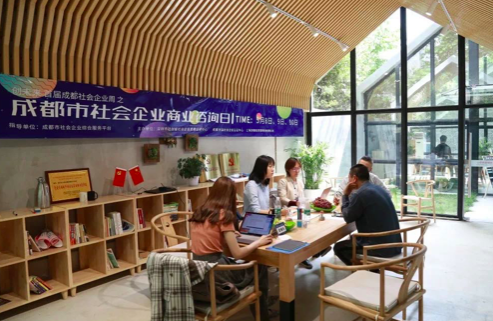
1. Overview of SEs: focus areas, income, entity nature
The SEs we served this time mainly focus on three areas: vulnerable group support, education and environment. Most SEs demonstrate the characteristics of “serving the community”, which is similar to SEs in the whole country.
At present, the income of most SEs is not of large size, the majority of which are in the early stage with annual income at million level. As Chengdu requires certified SEs to have “innovative business model and market-oriented operations”, their commercial thinking and market-oriented mechanisms have taken shape. Among the SEs we served, about 3/4 of them earn majority of their revenue from market sales than government purchase, and about 1/2 of them obtain almost all revenue from the market.
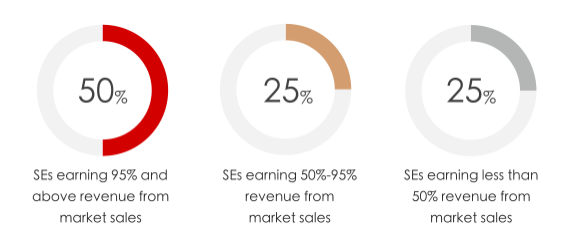
Chengdu has prescribed that certified SEs in Chengdu should have registered as “corporations”. Nearly half of the SEs we served have “dual” entity status, founding both a “corporation” and a “nonprofit organization”. While some are developed from social organizations to corporations, there are also cases where social organizations are derived from corporations. Usually, the two entities of SEs are complementary to each other in terms of business and functions, such as the separation of R&D and service teams, the separation between serving for-profit and nonprofit clients, and etc.
2. SEs’ FAQ: how to decide “What to do” and “How to do”
Before the consulting sessions, many SEs believe that one of the biggest problems hindering their own scaling-up and sustainable development was their lack of funds. As we walked through the situation of SEs with them, we find that “lack of funds” is in fact an outcome, which is resulted from the real problem of lacking strategy for institutional development. In other words, SEs need more structured consideration for decision-making on “what to do” and “how to do” in the development process.
When SEs are thinking about “what to do” and “how to do”, the key issues is to identify and prioritize potential options. While some may have ignored the high-potential options, some may not know how to do prioritization, and others may have simply taken in too much and thus lost focus .
To help more SEs figure out their own answers to “what to do” and “how to do”, we would like to share three core strategic considerations as below.
3. Three Core Strategic Considerations: Impact Driven, Demand Identification, Competitiveness Building
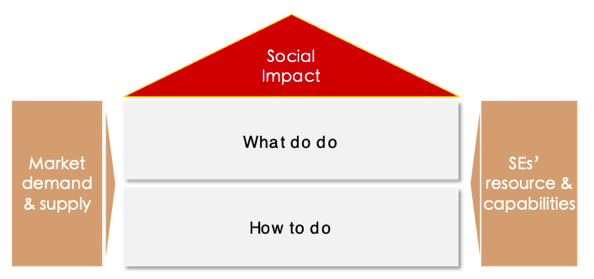
When SEs are considering “what to do” and “how to do”, strategic considerations are similar to those of commercial enterprises, with some special characteristics due to their social attributes. The biggest difference between SEs and commercial enterprises is the pursuit of “social impact”. Therefore, SEs’ strategy should be driven by social impact, together with the analysis of external market and internal well-being, so as to figure out “what to do” and “how to do”.
3.1 Impact Driven
Since one of SEs’ core objectives is to achieve social impact, their strategies can also be driven by “impact”, which means to first ascertain the intended social impact of the SE and then to develop the strategy for the realization and scale-up of the social impact. When SEs can clearly answer “why they exist”, they now have the direction for “what to do” and “how to do”.
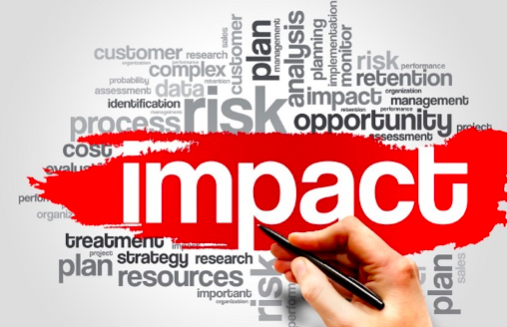
To be “impact driven”, SEs should always be able to clearly identify their intended impact. It is much harder in practice than in theory. We have seen three types of bottlenecks that SEs often encounter:
(1) Get distracted by too many new ideas
Some SEs continue to generate new and good wishes along the development process, and they keep developing new businesses to achieve those good wishes. As resource is limited and gets diluted for different causes, these organizations fail to develop any sustainable business model. In the situation where SEs come across multiple new ideas, SEs can consider whether there will be high level of synergy between those different ideas or between the new business and the existing one, before they decide whether to start a new business. In particular, in the case where the SE has not yet found its self-sustained business model, developing multiple low correlation businesses at the same time may lead to messy business development and improper resource allocation, further hindering the growth of the SE’s business as a whole.
(2) Forget to think about the intended impact
When considering its development, some SEs are immersed in the details of “how to do”, and forget that “how to do” is to better achieve impact. For example, the intended impact of an SE is community revitalization, and its initial business is to build a warm community based on community shopping. When thinking about business development, the founder’s focus is on “how to better develop community shopping” instead of “how to better revitalize the community via community shopping”, which has misled the team to allocate their core resources to accumulate competitive advantage in community e-commerce rather than community scene-building.
(3) Time to update the intended impact
Some SEs have already achieved intended impact with core business. it is time for such SEs to re-clarify the new impact targets for next stage of development, which may direct the organization to review new or non-core business and may even revitalize the SEs. For instance, after years of operation, an SE has achieved its intended impact to provide stable jobs for low-income people. The SE’s business is stable but stagnant for further development. As we helped this SE to sort out the impact targets of the existing business lines, we found that one of its current non-core businesses can make the initial impact target largely expanded – not only providing jobs with higher rates for the low-income population, but also serving the communities lived by low-income people and vulnerable groups living in these communities. Therefore, this non-core business might become the strategic focus for the SE’s next stage of development.
3.2 Demand Identification
Like all the other commercial enterprises, in order to find a sustainable business model, an SE needs to identify the market demand, i.e. to answer the fundamental questions of “who will pay for what”. In terms of “who”, it can usually be divided into two basic categories: government and the market. It is worth noting that the payer and the direct service recipient may not always be the same person. An SE needs to distinguish whether the demand of these two parties are different and, if so, priorities shall be given to the payer’s demand.
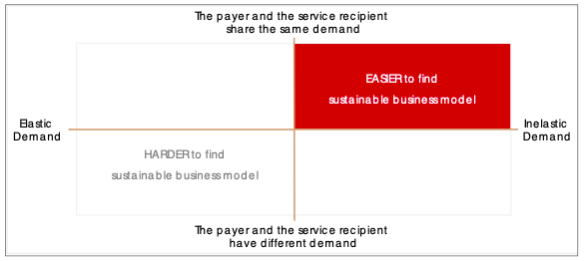
Take an SE focusing on the issue of community education as an example. While the SE’s dominant payer is the local government, elderly groups in the communities are the major audience of the courses, i.e. the main direct service recipients. If the SE wants continue to serve the elderly groups in the future, but to get paid by the “market” instead of the government, it needs to further break down the “market” and see if its products/courses need to iterate. The questions the SE need to answer in the thinking process may include: if the elderly groups are the payer, what exactly do they need? If the children of the elderly groups are the payers, what is their demand, and how is it different from that of the elderly groups?Which party’s demand does the current product/course satisfy and is such demand an inelastic one?
3.3 Competitiveness Building
In addition to identifying market demand, SEs, like other commercial enterprises, need to understand where their competitive advantage lies and answer the question “Why I can be the one to better meet the need?”. Despite of competitor analysis, SEs should also review their own experience and resources to find their best path to deepen their competitive advantage.
As mentioned above, there is an SE that based on community shopping to revitalize communities. This SE can easily obtain local community resources, and has professional experience and capabilities in community revitalization, which has been recognized by other partners and stakeholders. Therefore, the team should choose the path where they are able to utilize their experience and resources in “community revitalization” so as to establish their unique competitiveness in the market.
We see a bright future for SEs, and hope that SEs can keep driving themselves with their intended “impact” and find their sustainable and scalable development path with internal and external analysis. VA will keep paying close attention to the development of SEs in China and cooperate with all stakeholders to boost the development of social innovation in China.
